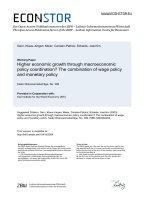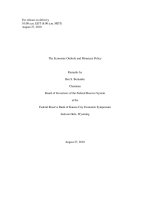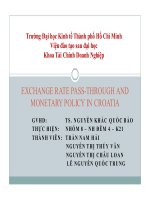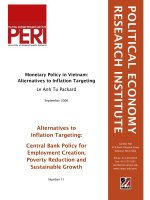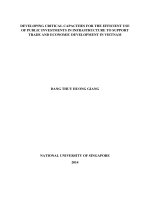inflation dynamics and monetary policy in vietnam
Bạn đang xem bản rút gọn của tài liệu. Xem và tải ngay bản đầy đủ của tài liệu tại đây (3.22 MB, 56 trang )
Rina Bhattacharya and Nombulelo Duma
International Monetary Fund
1
Plan of the Presentation
Background and
Literature
•Background
•Inflation dynamics
•Channels of monetary transmission
The Model and
•Theoretical model
•Data
Results
•Single equation
•Structural vector auto-regression
Policy Implications
and Conclusions
and Conclusions
2
3
Vietnam has made good progress over the past
Vietnam
has
made
good
progress
over
the
past
three decades and has many strengths
Transition from a centrall
y
-planned to a ‘socialist
oriented market economy;
A
n average of 9 percent real GDP growth per year;
Location in a dynamic region;
An abundant, young and rapidly growing labor force ;
Relatively low labor costs;
Relatively low labor costs;
Relatively high savings rate and a high investment rate
compared to its regional peers.
compared to its regional peers.
4
Hhll iildi
H
owever, c
h
a
ll
enges rema
i
n,
i
nc
l
u
di
ng:
Sl GD h i
Sl
ower
GD
P
growt
h i
n
recent
years;
A large, thinly-capitalized and heavily state-owned
bki
b
an
ki
ng
system;
A shallow domestic capital market;
High and volatile inflation compared to trading
partners
5
There have been many episodes of high inflation
Many cycles of high inflation—stabilization—high
inflation…
1
986
-
88:
h
ype
r infl
at
i
o
n
,
w
i
t
h
a
nn
ua
l r
ates
e
x
ceed
in
g
300
986
88: ype at o , w t a ua ates e ceed g
300
percent;
Monetary and fiscal policy tightened
Iflti d d t bl t i d t l t
I
n
fl
a
ti
on
d
roppe
d t
o
b
e
l
ow
20
percen
t i
n
1992
an
d t
o
c
l
ose
t
o
10 percent in 1995
2004 and mid-2008: peaked at 25 percent in 2008
Due in large part to rising international commodity prices
and excess domestic demand
Once domestic demand and commodit
y
p
rices weakened
,
yp ,
inflation dropped to 2.5 percent in mid 2009.
6
High inflation episodes continued
Late 2010 to mid 2011: inflation reached 20.3 percent in
the third quarter of 2011
Contributing factors
-fiscal stimulus; loose monetary
policy; high commodity prices.
7
hbl hhhfl lk
T
h
e pro
bl
em wit
h
h
ig
h
in
fl
ation raises severa
l
k
ey
issues
Macroeconomic management;
Monetary policy goals;
Monetary policy transparency and predictability;
Prevalent use of caps on interest rates and
Prevalent use of caps on interest rates and
administrative controls on credit;
H
ow
does
t
h
e
m
o
n
eta
r
y
po
li
cy
t
r
a
n
s
mi
ss
i
o
n
ow does t e o eta y po cy t a s ss o
mechanism operate in Vietnam?
8
df lh lf
Literature i
d
enti
f
ies severa
l
c
h
anne
l
s o
f
monetary
transmission
Traditional interest rate channel
Exchange rate channel
Credit channel
Th
e
ba
nk l
e
n
d
in
g
c
h
a
nn
e
l
eba e d gc a e
The balance sheet channel
Asset price channel
Asset price channel
Expectations channel
9
10
hh l dlb d b
T
h
e t
h
eoretica
l
mo
d
e
l
is
b
ase
d
on two
b
asic
relationships in economic theory
Long-run Purchasing Power Parity for the composition
of the overall domestic price index; and
Equilibrium in the money market based on a specified
money demand function
11
The overall price index has the following
The
overall
price
index
has
the
following
relationship:
P = P
D
μ
(EP
*
)
1-μ
(1)
Where P
D
is the domestic price and P
*
is the foreign
p
rice.
p
12
Equilibrium in the money market over the
Equilibrium
in
the
money
market
over
the
long run is given by
M
S
/P = M
D
/P = α + β
1
Y + β
2
R + η (2)
Here
,
real mone
y
su
pp
l
y (
M
S
/P
)
ad
j
usts to meet real mone
y
,
yppy(
/
)j y
demand (M
D
/P), where real money demand is a function of
output Y (real GDP) and the real interest rate R
η
represents shocks to real money demand.
β
1
is expected to be positive (money demand is a positive
function of income or output)
function of income or output)
13
Combining equations (1) and (2) gives:
p = F(m, r, e, y, p
*
; Z) = Xγ + Zθ + ε (3)
the overall price level is a function of the money
supply, real GDP, the nominal effective exchange rate,
foreign inflation, and the real interest rate;
ll l d l l h l
sma
ll
l
etters in
d
icate natura
l
l
ogarit
h
m va
l
ues, X =
(m, r, e, y, p
*
), Z is a set of control variables, and ε is an
error term
error term
14
There is a close relationship between core
inflation and real interest rates; but less so
with credit
20
Core Inflation
Vietnam: Core Inflation, the Real Interest Rate, and Growth in Credit to
the Economy
60
5
10
15
Core
Inflation
Real interest rate
40
50
60
Core Inflation
Credit to economy
-5
0
5
20
30
-20
-15
-10
-
10
0
10
1998Q1
1999Q1
2000Q1
2001Q1
2002Q1
2003Q1
2004Q1
2005Q1
2006Q1
2007Q1
2008Q1
2009Q1
2010Q1
10
1998Q1
1999Q1
2000Q1
2001Q1
2002Q1
2003Q1
2004Q1
2005Q1
2006Q1
2007Q1
2008Q1
2009Q1
2010Q1
15
lfhd d
Statistica
l
properties o
f
t
h
e
d
ata were assesse
d
and necessary transformations made
The null hypothesis of a unit root can be rejected for all the
variables based on ADF ‘t’ and PP ‘Z’ unit root tests;
Real GDP was seasonally adjusted using the
TRAMO/SEATS seasonal adjustment procedure;
All the variables are in percentage changes over the
previous year, except for :
h l i h h b l h h
t
h
e
rea
l i
nterest
rate
w
h
ere
t
h
e
a
b
so
l
ute
c
h
ange
over
t
h
e
previous year is used;
Inflation, where the percentage change in prices over the
Inflation, where the percentage change in prices over the
following four quarters is used;
16
Single equation estimation reveals several things:
1
Real interest rates ha e a strong and significant
1
.
Real interest rates ha
v
e a strong and significant
negative impact on core inflation, with a lag
Change in Real interest rate
-
0115
-
098
Change in Real interest rate
-0 761
-1 55
Model with credit Model with money
Change
in
Real
interest
rate
0
.
115
0
.
98
L1 -0.726
***
-5.85
L2 0.645
***
7.29
Change
in
Real
interest
rate
-0
.
761
-1
.
55
L1 -0.205 -0.55
L2 0.419 1.09
**
L3 -0.020 -0.12
L4 -0.648
***
-5.10
L5 0.519
***
3.42
L3 -0.824
**
-2.47
L4 -0.025 -0.10
L5 0.760 1.41
17
Si l i i i h h
Si
ng
l
e equat
i
on est
i
mat
i
on s
h
ows t
h
at:
3
.Credit
g
rowth
/
mone
y
su
pp
l
y
g
rowth variables also
3
g/yppyg
have a significant but delayed impact on core inflation
Model with credit Model with money
Growth in credit to the economy
0.103
1.00
Growth in M2 Money Supply
-
1.411
-
1.28
Growth
in
credit
to
the
economy
0.103
1.00
L1 0.590
***
4.55
L2 -0.846
***
-6.10
L3
0 321
***
470
Growth
in
M2
Money
Supply
1.411
1.28
L1 -0.736 * -1.94
L2 1.096
**
2.47
L3
0 017
010
L3
0
.
321
4
.
70
L4 0.167
***
3.05
L5 0.113
**
1.97
L3
0
.
017
0
.
10
L4 0.286
**
*
2.76
L5 0.801 1.40
18
Single equation estimation further shows that:
3
We cannot reject the null hypothesis that the
3
.
We cannot reject the null hypothesis that the
instrument set is uncorrelated with the error term
Model with credit Model with money
Hansen J-statistic 1.267
Chi-squared P
-
0.260
Hansen J-statistic 1.417
Chi-squared P
-
0.234
19
Single equation estimation further shows that:
4
We strongly reject the null hypothesis that the
4
.
We strongly reject the null hypothesis that the
coefficients on the real interest rate variables and on the
credit growth / M2 money supply growth variables are
jointl insignificant based on joint significance tests
jointl
y
insignificant based on joint significance tests
Model with credit Model with money
Test on significance of interest rate variable:
Chi-s
q
uared value 1426.98
Test on significance of interest rate variable:
Chi-s
q
uared value 52.18
q
Chi-squared P-value 0.00
Test on significance of credit growth variabl
e
Chi-squared value
360 76
q
Chi-squared P-value 0.00
Test on significance of M2 Money Supply variable:
Chi-squared value
35 35
Chi-squared
value
360
.
76
Chi-squared P-value 0.00
Chi-squared
value
35
.
35
Chi-squared P-value 0.00
20
hlhhflll
T
h
e Structura
l
VAR
h
as t
h
e
f
o
ll
owing
l
ong-run
restrictions
Inflation shocks have no long-run impact on any of
the other variables in the system;
Shocks to the nominal effective exchange rate have a
long-term impact on domestic inflation.
Credit shocks have a long-term impact on inflation
and on the nominal effective exchange rate but not on
the real interest rate output growth or foreign
the real interest rate
,
output growth
,
or foreign
inflation.
21
hlhhflll
T
h
e Structura
l
VAR
h
as t
h
e
f
o
ll
owing
l
ong-run
restrictions
Shocks to the real interest rate have no long-term
impact on output growth or on foreign inflation.
Output shocks have a long-term impact on all the
variables in the system except foreign inflation.
Foreign inflation is truly exogenous, affecting all the
other variables in the system in the long-run but not
affected by any of them
affected by any of them
.
22
h
bhlk
S
h
ort-run restrictions are given
b
y C
h
o
l
es
k
y
decomposition, which implies :
Inflation shocks have no contemporaneous impact
on any of the other variables in the system;
Output shocks only have a contemporaneous
impact on domestic inflation.
Credit shocks have a contemporaneous impact on
domestic inflation and on the nominal effective
exchange rate but not on the real interest rate,
output growth, or foreign inflation.
23
…and:
Shocks to the real interest rate have no contemporaneous
impact on output growth or on foreign price inflation.
il ff i h hk h
Nom
i
na
l
e
ff
ect
i
ve
exc
h
ange
rate
s
h
oc
k
s
h
ave
a
contemporaneous impact on all the variables in the system
exce
p
t forei
g
n inflation.
pg
Foreign inflation is truly exogenous, affecting all the other
variables in the system but not affected by any of them
contemporaneously.
24
Other properties of the VAR include:
VAR lag length of 5 was selected based on the Akaike
and Schwarz Information Criteria;
Elasticities of inflation to the real interest rate and
money supply are computed from the impulse
responses by dividing the cumulative impulse
responses by dividing the cumulative impulse
responses of inflation after j months by the cumulative
res
p
onses of the real interest rate (credit to the
p
economy) shock after j months.
25

